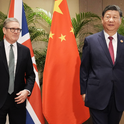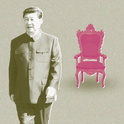Read more of our big ideas of 2015
China’s assertiveness in the South China Sea is raising fears that it is bent on turning the maritime region into “a Chinese lake.” Shinzo Abe, Japan’s Prime Minister, has already accused it of trying to create “Lake Beijing” by extending its influence and military operations while pressing its claim to disputed territories (as indicated by the “Nine-Dash Line” its governments have drawn on maps of the region since 1947). The coming year will show whether it is prepared to abide by UN conventions and arbitration, and how much the US is prepared to defend its allies in what had been described, in the decades after the Second World War, as a “veritable American naval lake.” The South China Sea, as it is mainly called internationally—but called the South Sea by China, the East Sea by Vietnam, and increasingly the East Philippine Sea by Philippine officials—has been one of the world’s richest cultural and commercial exchanges. A third of the world’s shipping goes through its waters, and it is an important fishing ground.
But it has been a source of territorial tension for centuries, much of that focused on the hundreds of small islands. China and the Philippines both have claims on the Scarborough Shoal; China and Vietnam contest the Paracel Islands; and China, Vietnam, the Philippines, Brunei and Malaysia all claim the Spratlys. China and Japan also dispute the islands called the Senkaku by Japan and the Diaoyu by China. And China and Taiwan both claim the Pratas Islands.
The stakes have risen with the soaring value of the fishing grounds and with evidence of natural reserves below the sea bed—some suggest 11bn barrels of oil and 190 trillion cubic feet of natural gas.
In 2014, China stepped up military exercises and moved to install an airstrip and harbour capable of supporting military craft in the Spratlys. In March, it refused to accept arbitration with the Philippines over the island dispute under the UN Convention on the Law of the Sea. In May, it moved an oil rig into disputed territory west of the Paracel Islands, triggering huge protests across Vietnam. It has also tried to stop US vessels operating within 370km of its shores, its Exclusive Economic Zone, which many regard as a breach of the UN convention. Abe now calls for Japan to form a “diamond” with the US, Australia and India to counter Chinese influence. On 2nd October, the US lifted part of a ban on selling weapons to Vietnam, to help it improve its security at sea. On 28th October, India said it would sell naval vessels to Vietnam in exchange for an energy-exploration deal.
Chinese President Xi Jinping has trumpeted an “Asian security concept” which calls for “Asian solutions to Asian problems”—meaning America or Australia, keep out. But optimists point to its cooperation with the US and Japan in Rim of the Pacific naval exercises in the summer. Maybe. But 2015 will show whether China is prepared to negotiate—and to recognise UN conventions—or not.
China’s assertiveness in the South China Sea is raising fears that it is bent on turning the maritime region into “a Chinese lake.” Shinzo Abe, Japan’s Prime Minister, has already accused it of trying to create “Lake Beijing” by extending its influence and military operations while pressing its claim to disputed territories (as indicated by the “Nine-Dash Line” its governments have drawn on maps of the region since 1947). The coming year will show whether it is prepared to abide by UN conventions and arbitration, and how much the US is prepared to defend its allies in what had been described, in the decades after the Second World War, as a “veritable American naval lake.” The South China Sea, as it is mainly called internationally—but called the South Sea by China, the East Sea by Vietnam, and increasingly the East Philippine Sea by Philippine officials—has been one of the world’s richest cultural and commercial exchanges. A third of the world’s shipping goes through its waters, and it is an important fishing ground.
But it has been a source of territorial tension for centuries, much of that focused on the hundreds of small islands. China and the Philippines both have claims on the Scarborough Shoal; China and Vietnam contest the Paracel Islands; and China, Vietnam, the Philippines, Brunei and Malaysia all claim the Spratlys. China and Japan also dispute the islands called the Senkaku by Japan and the Diaoyu by China. And China and Taiwan both claim the Pratas Islands.
The stakes have risen with the soaring value of the fishing grounds and with evidence of natural reserves below the sea bed—some suggest 11bn barrels of oil and 190 trillion cubic feet of natural gas.
In 2014, China stepped up military exercises and moved to install an airstrip and harbour capable of supporting military craft in the Spratlys. In March, it refused to accept arbitration with the Philippines over the island dispute under the UN Convention on the Law of the Sea. In May, it moved an oil rig into disputed territory west of the Paracel Islands, triggering huge protests across Vietnam. It has also tried to stop US vessels operating within 370km of its shores, its Exclusive Economic Zone, which many regard as a breach of the UN convention. Abe now calls for Japan to form a “diamond” with the US, Australia and India to counter Chinese influence. On 2nd October, the US lifted part of a ban on selling weapons to Vietnam, to help it improve its security at sea. On 28th October, India said it would sell naval vessels to Vietnam in exchange for an energy-exploration deal.
Chinese President Xi Jinping has trumpeted an “Asian security concept” which calls for “Asian solutions to Asian problems”—meaning America or Australia, keep out. But optimists point to its cooperation with the US and Japan in Rim of the Pacific naval exercises in the summer. Maybe. But 2015 will show whether China is prepared to negotiate—and to recognise UN conventions—or not.













